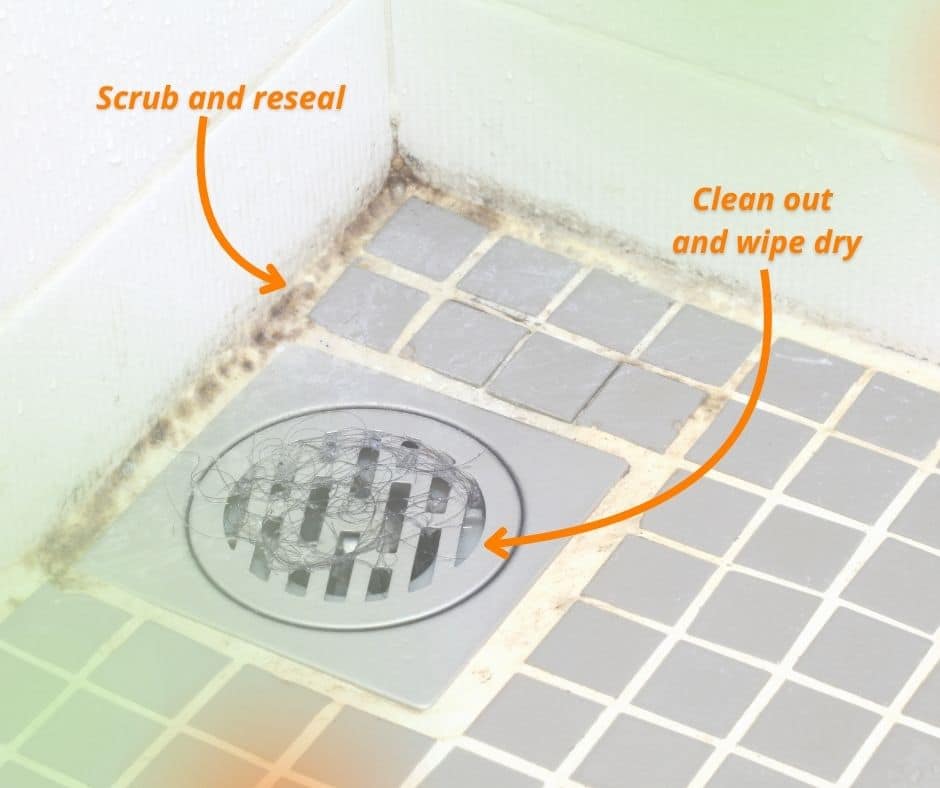According to the EPA, mold is found in over half of U.S. homes— and your bathroom is its favorite secret hideout. Moisture lingers, mold pounces, and suddenly you’re paying for repairs you need or want to spend on something else.
Here’s the bright side: a little diligence goes a long way. Our bathroom cleaning checklist is inspired by what we see in real homes, day in and day out — it’s practical, doable, and designed to keep mold from crashing your peaceful, steamy showers.
Table of Contents
ToggleThe Bathroom Cleaning Checklist
This isn’t just a wipe-and-go list. These steps are designed to keep moisture problems from turning into mold growth, water damage, or bigger issues that might show up on an inspection report down the road.
1. Clean the grout and tile thoroughly
Mold thrives in the tiny cracks between tiles where water lingers. Use a mildew-fighting cleaner or a paste made of baking soda and water. Scrub grout lines with a stiff brush or old toothbrush. Scrub grout lines, tub bases, shower door tracks, and the corners where tile meets tub or wall — the molds’ secret party zones.
Pro tip: Do this once a week, more if you’ve got poor ventilation or see suspicious spots.
2. Dry all surfaces after use
After every shower or bath, use a towel or squeegee to wipe down the shower walls, doors, and tub. It may seem like an extra step, but it goes a long way in preventing standing moisture. Water left overnight on tile or plastic surfaces creates a perfect environment for mold spores to grow.
Also wipe down the counters, sink, and any surfaces that collect water droplets during daily use.

3. Don’t skip behind or under things
Pull out the trash can, clean behind the toilet, and check under the vanity regularly. These hidden areas often trap humidity and collect dust and hair, which can hold moisture. Wipe them clean with a disinfectant and let the area air dry fully.
Once a month, move items temporarily to get a full cleaning of the floor and wall corners.
4. Deep clean your exhaust fan
A dirty fan can’t do its job. The fan is your bathroom’s best defense against lingering moisture. A single shower can push bathroom humidity to 100%, and without a functioning fan, that moisture lingers long after you’ve dried off.
Turn off the power, remove the vent cover, and use a vacuum or cloth to clear out any debris. Make sure it’s working well, and run it during every shower and for 15 to 20 minutes afterward.
If your fan is noisy or doesn’t seem to pull air, something is up.
5. Empty and sanitize drains
Slow drains lead to water buildup. Pour a cup of baking soda followed by a cup of vinegar down your drains once a week. Let it sit for 10 minutes, then rinse with boiling water. This helps break down hair, soap, and other buildup.
You can also remove the drain stopper and scrub it with an old toothbrush to clear hidden grime.
6. Wash soft items that hold moisture
Bath mats, towels, and shower curtains all absorb water. If they’re not dried properly or washed regularly, they become breeding grounds for mold. Wash them once a week in hot water, and hang them up to dry completely after each use.
For plastic or vinyl shower liners, replace them every few months or clean with vinegar spray to prevent mold from forming along the bottom edge.
7. Inspect caulk and sealants
Look around your tub, sink, and toilet. If you see cracked, peeling, or missing caulk, reseal it. Water seeps into those gaps and causes mold to grow behind the walls or under the floor.
Use a mildew-resistant caulk and apply it to clean, dry surfaces. Make this part of your seasonal bathroom maintenance.

Other Helpful Maintenance Tips
Cleaning helps, but there are a few extra things you can do to reduce moisture in the bathroom even more.
-
- Keep the door open after showers to let air circulate
-
- Use a humidity sensor or keep a small dehumidifier in the bathroom if it stays damp
-
- Upgrade your fan if it’s weak or noisy; it might not be doing enough
-
- Make sure water drains properly from the shower and sink; poor drainage can signal a larger issue
When to Call an Inspector
Sometimes, mold grows where you can’t see it. If your bathroom smells musty even after a deep clean, or if you’re seeing discoloration on the ceiling, peeling paint, or soft drywall, it could be time for a closer look.
Conclusion
Bathrooms deal with a lot of water, and that makes them a hotspot for mold and hidden damage. But with the right cleaning checklist and a little attention to detail, you can keep your bathroom in great shape. Use this checklist to stay consistent, catch problems early, and keep your space clean and safe.
And if you ever want a second set of eyes, the team at Inspection Gator is here to help. Schedule your inspection with confidence. This isn’t a quick swipe and sprint. These steps dig deeper — protecting your grout, your wallet, and your future inspection report from moisture’s mischief.





